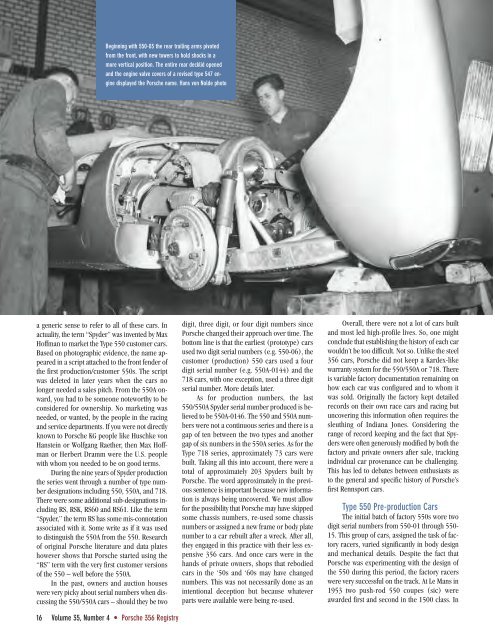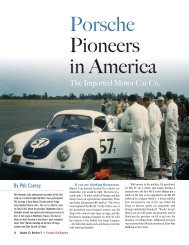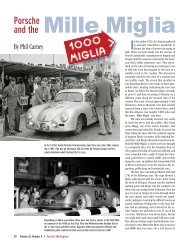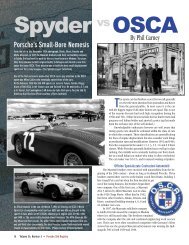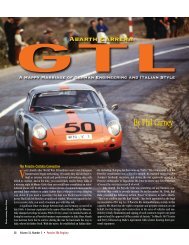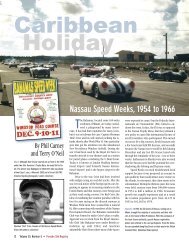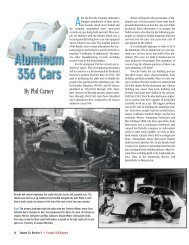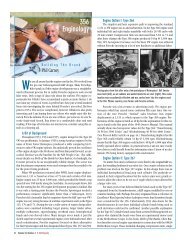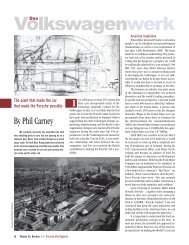You also want an ePaper? Increase the reach of your titles
YUMPU automatically turns print PDFs into web optimized ePapers that Google loves.
Beginning with 550-03 the rear trailing arms pivoted<br />
from the front, with new towers to hold shocks in a<br />
more vertical position. The entire rear decklid opened<br />
and the engine valve covers of a revised type 547 engine<br />
displayed the <strong>Porsche</strong> name. Hans von Nolde photo<br />
a generic sense to refer to all of these cars. In<br />
actuality, the term “Spyder” was invented by Max<br />
Hoffman to market the Type 550 c<strong>us</strong>tomer cars.<br />
Based on photographic evidence, the name appeared<br />
in a script attached to the front fender of<br />
the first production/c<strong>us</strong>tomer 550s. The script<br />
was deleted in later years when the cars no<br />
longer needed a sales pitch. From the 550A onward,<br />
you had to be someone noteworthy to be<br />
considered for ownership. No marketing was<br />
needed, or wanted, by the people in the racing<br />
and service departments. If you were not directly<br />
known to <strong>Porsche</strong> KG people like H<strong>us</strong>chke von<br />
Hanstein or Wolfgang Raether, then Max Hoffman<br />
or Herbert Dramm were the U.S. people<br />
with whom you needed to be on good terms.<br />
During the nine years of Spyder production<br />
the series went through a number of type number<br />
designations including 550, 550A, and 718.<br />
There were some additional sub-designations including<br />
RS, RSK, RS60 and RS61. Like the term<br />
“Spyder,” the term RS has some mis-connotation<br />
associated with it. Some write as if it was <strong>us</strong>ed<br />
to distinguish the 550A from the 550. Research<br />
of original <strong>Porsche</strong> literature and data plates<br />
however shows that <strong>Porsche</strong> started <strong>us</strong>ing the<br />
“RS” term with the very first c<strong>us</strong>tomer versions<br />
of the 550 – well before the 550A.<br />
In the past, owners and auction ho<strong>us</strong>es<br />
were very picky about serial numbers when disc<strong>us</strong>sing<br />
the 550/550A cars – should they be two<br />
16 Volume 35, Number 4 • <strong>Porsche</strong> 356 Registry<br />
digit, three digit, or four digit numbers since<br />
<strong>Porsche</strong> changed their approach over time. The<br />
bottom line is that the earliest (prototype) cars<br />
<strong>us</strong>ed two digit serial numbers (e.g. 550-06), the<br />
c<strong>us</strong>tomer (production) 550 cars <strong>us</strong>ed a four<br />
digit serial number (e.g. 550A-0144) and the<br />
718 cars, with one exception, <strong>us</strong>ed a three digit<br />
serial number. More details later.<br />
As for production numbers, the last<br />
550/550A Spyder serial number produced is believed<br />
to be 550A-0146. The 550 and 550A numbers<br />
were not a continuo<strong>us</strong> series and there is a<br />
gap of ten between the two types and another<br />
gap of six numbers in the 550A series. As for the<br />
Type 718 series, approximately 73 cars were<br />
built. Taking all this into account, there were a<br />
total of approximately 203 <strong>Spyders</strong> built by<br />
<strong>Porsche</strong>. The word approximately in the previo<strong>us</strong><br />
sentence is important beca<strong>us</strong>e new information<br />
is always being uncovered. We m<strong>us</strong>t allow<br />
for the possibility that <strong>Porsche</strong> may have skipped<br />
some chassis numbers, re-<strong>us</strong>ed some chassis<br />
numbers or assigned a new frame or body plate<br />
number to a car rebuilt after a wreck. After all,<br />
they engaged in this practice with their less expensive<br />
356 cars. And once cars were in the<br />
hands of private owners, shops that rebodied<br />
cars in the ‘50s and ‘60s may have changed<br />
numbers. This was not necessarily done as an<br />
intentional deception but beca<strong>us</strong>e whatever<br />
parts were available were being re-<strong>us</strong>ed.<br />
Overall, there were not a lot of cars built<br />
and most led high-profile lives. So, one might<br />
conclude that establishing the history of each car<br />
wouldn’t be too difficult. Not so. Unlike the steel<br />
356 cars, <strong>Porsche</strong> did not keep a Kardex-like<br />
warranty system for the 550/550A or 718. There<br />
is variable factory documentation remaining on<br />
how each car was configured and to whom it<br />
was sold. Originally the factory kept detailed<br />
records on their own race cars and racing but<br />
uncovering this information often requires the<br />
sleuthing of Indiana Jones. Considering the<br />
range of record keeping and the fact that <strong>Spyders</strong><br />
were often genero<strong>us</strong>ly modified by both the<br />
factory and private owners after sale, tracking<br />
individual car provenance can be challenging.<br />
This has led to debates between enth<strong>us</strong>iasts as<br />
to the general and specific history of <strong>Porsche</strong>’s<br />
first Rennsport cars.<br />
Type 550 Pre-production Cars<br />
The initial batch of factory 550s wore two<br />
digit serial numbers from 550-01 through 550-<br />
15. This group of cars, assigned the task of factory<br />
racers, varied significantly in body design<br />
and mechanical details. Despite the fact that<br />
<strong>Porsche</strong> was experimenting with the design of<br />
the 550 during this period, the factory racers<br />
were very successful on the track. At Le Mans in<br />
1953 two p<strong>us</strong>h-rod 550 coupes (sic) were<br />
awarded first and second in the 1500 class. In


